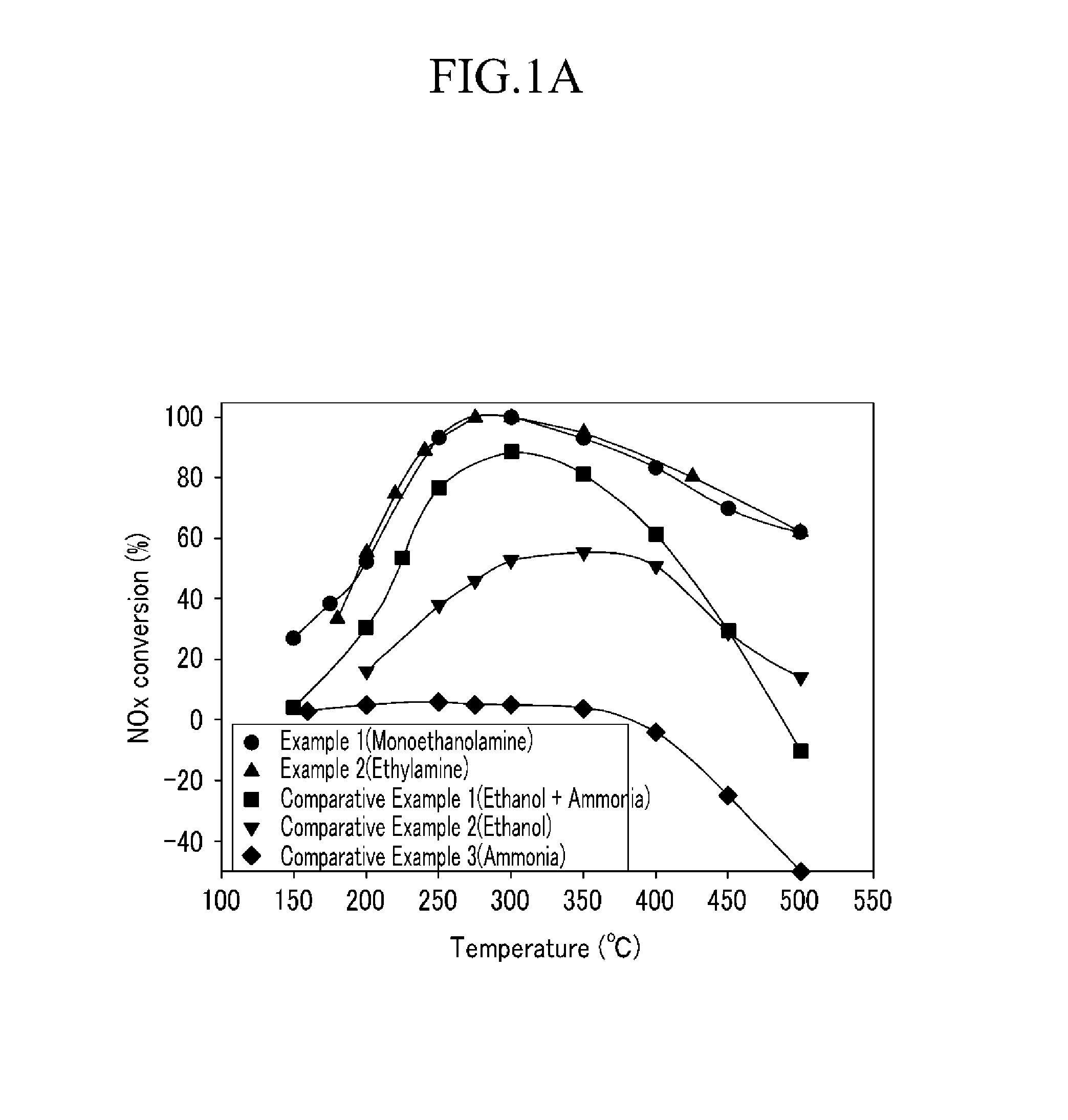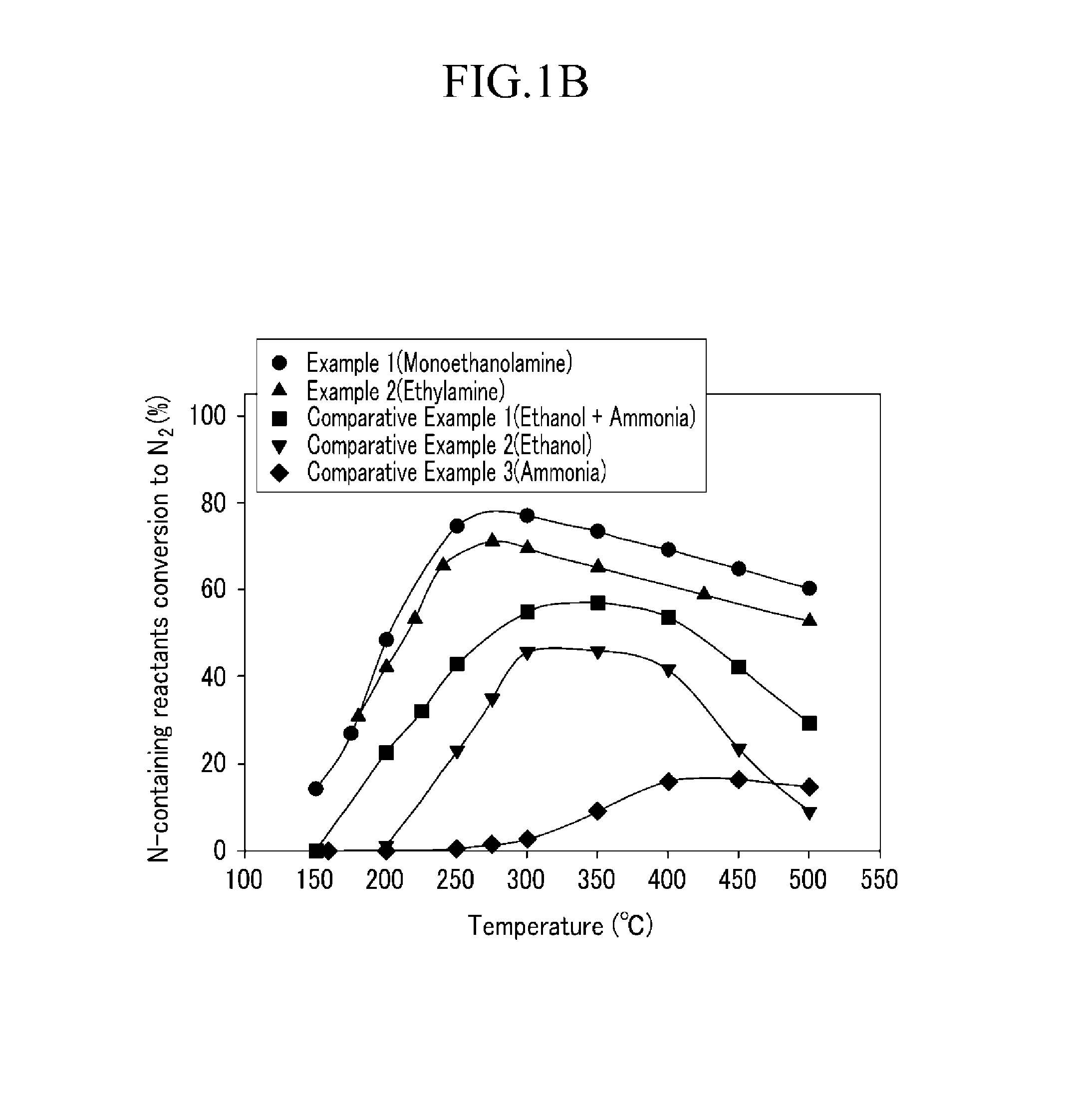Method of reducing nitrogen oxide using amine compound as reductant
a technology of nitrogen oxide and amine compound, which is applied in the direction of arsenic compounds, silicon compounds, separation processes, etc., can solve the problems of urea/scr technology having technical inferiorities, exhaustion of nitrogen oxide and particulate materials, and reducing the efficiency of nitrogen oxide removal
- Summary
- Abstract
- Description
- Claims
- Application Information
AI Technical Summary
Benefits of technology
Problems solved by technology
Method used
Image
Examples
preparation examples 1 to 7
[0051]An AgNO3 solution was impregnated onto γ-Al2O3 (BET=207 m2 / g) to reach the amounts of Ag supported onto γ-Al2O3 of 2, 4, and 6 wt. %, respectively, and the resulting material was dried in the oven at 110° C. for 12 hours and calcined at 550° C. for 5 hours to prepare the Ag / Al2O3 catalyst (Preparation Examples 1, 2, and 3).
[0052]The Fe-ZSM5, Cu-ZSM5, and Cu-SSZ13 catalysts were prepared by ion-exchanging ZSM5 (BET=360 m2 / g) or SSZ13 (BET=480 m2 / g) with 0.01M of the Fe(NO3)3.9H2O or Cu(CH3COO)2.H2O solution to reach the amount of Fe or Cu was about 3 wt. %, and drying the resulting materials in the oven at 110° C. for 12 hours, and calcining the materials at 550° C. for 5 hours (Preparation Examples 4, 5, and 6).
[0053]The MnFe / ZSM5 catalyst was prepared by simultaneously impregnating the Mn(NO3)2.6H2O and Fe(NO3)3.9H2O solutions in ZSM5 to reach the amount of Mn and Fe of 30 wt. % and 10 wt. %, respectively, and calcining the resulting materials at 500° C. for 5 hours while blo...
example 1
[0054]The catalyst (Ag / Al2O3, the amount of Ag was 4 wt. %) prepared in Preparation Example 2 was put into the catalyst reaction device, and before the nitrogen oxide removing ratio was measured, pretreatment was performed under the mixed gas including 2.5 volume % of H2O, 6 volume % of O2, and the residual amount of He, at the temperature of 550° C. for 2 hours.
[0055]After the pretreatment, 400 ppm of NO, 2.5 volume % of H2O, 6 volume % of O2, and the residual amount of He were injected, and 400 ppm of NH2(CH2)2OH was injected as the reductant. In this case, the space velocity was set to 60,000 and after the normal state was maintained at the reaction temperature of each of 150° C., 175° C., 200° C., 250° C., 300° C., 350° C., 400° C., 450° C., and 500° C. for 2 hours, the activity at each reaction temperature was measured. Further, the mixing ratio (MEA / NOX) of monoethanolamine / nitrogen oxide was set to 1.
example 2
[0056]The catalyst reaction was performed by the same procedure as Example 1, except that 400 ppm of NH2CH2CH3 was injected as the reductant, the reaction temperature was changed to 180° C., 200° C., 220° C., 240° C., 275° C., 300° C., 350° C., 425° C., and 500° C., and the normal state was maintained at each reaction temperature for 2 hours to perform the reaction.
PUM
| Property | Measurement | Unit |
|---|---|---|
| temperature | aaaaa | aaaaa |
| temperature | aaaaa | aaaaa |
| temperatures | aaaaa | aaaaa |
Abstract
Description
Claims
Application Information
 Login to View More
Login to View More - R&D
- Intellectual Property
- Life Sciences
- Materials
- Tech Scout
- Unparalleled Data Quality
- Higher Quality Content
- 60% Fewer Hallucinations
Browse by: Latest US Patents, China's latest patents, Technical Efficacy Thesaurus, Application Domain, Technology Topic, Popular Technical Reports.
© 2025 PatSnap. All rights reserved.Legal|Privacy policy|Modern Slavery Act Transparency Statement|Sitemap|About US| Contact US: help@patsnap.com



